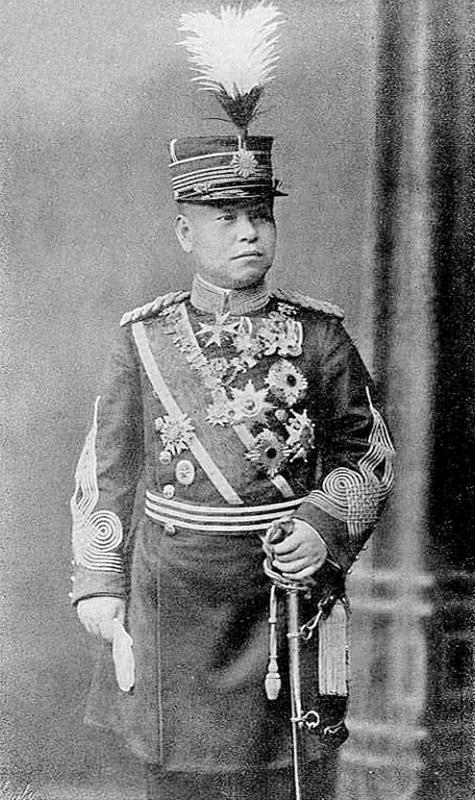May 9 to May 15
Poisoned dagger in hand, Korean national Cho Myeong-ha pushed aside the cheering schoolchildren and lunged at Prince Kuni Kuniyoshi’s roofless car. He swiped once and missed. As the car sped up, Cho threw the dagger. But its unclear what happened next on the streets of Taichu (Taichung) on May 14, 1928.
According to post-war Korean sources, the dagger grazed the prince and inflicted a minor injury before hitting the driver in the back. The poison soon spread through Kuniyoshi’s body, and he died the following January in Tokyo. Japanese accounts, however, maintain that Cho missed once more, and the prince died later from an unrelated illness.

Photo courtesy of Wikimedia Commons
Chen Wei-han (陳煒翰) offers another explanation in the book, Japanese Royals Visit Taiwan (日本皇族台灣行旅): the prince emerged unharmed but was rattled by the close call, dying later from psychological duress. He was 56 years old.
Cho reportedly told the crowd after his arrest: “Don’t be afraid, I am only taking revenge for the Korean Empire. Long live Korea!”
He tried to commit suicide by ingesting morphine, but vomited it out and survived. The 23-year-old was sentenced to death and executed in Taipei on Oct. 10.

Photo courtesy of Wikimedia Commons
The incident led to the high-profile resignations of Taiwan governor-general Mitsunoshin Kamiyama, chief secretary Fumio Koto, police commissioner Bunpei Motoyama and Taichu Prefecture governor Tsuzuku Sato.
DIFFERING MOTIVES
Cho was born in 1905, the year Korea became a protectorate of Japan. Five years later, Japan formally annexed his homeland. Former Korean emperor Gojong’s sudden death in 1919 was widely speculated to be due to poisoning by the Japanese, sparking massive protests on March 1, which were brutally suppressed.

Photo courtesy of National Central Library
Unrest erupted again on June 10, 1926, with the death of King Sunjong, this time mostly involving students. Cho had just gotten married and secured a job as secretary with the local government, but he soon quit and allegedly traveled to Japan to plan an uprising, as strict surveillance made any further action impossible back home.
Again, accounts differ depending on which side is telling the story. His verdict states that he was simply unhappy with the low pay of his job and went to Japan to further his studies. He was having trouble making ends meet and set his sights on Taiwan, which he heard was a “land of abundance” with many opportunities for economic development.
However, Taiwanese and Korean accounts indicate that Taiwan was just a pit stop on Cho’s way to join the Korean government-in-exile in Shanghai. Unable to find a job in Taipei, he traveled to Taichung and started working on a Japanese-owned tea farm. He became bitter that Koreans earned only half the salary of the Japanese, and his boss repeatedly reneged on his promise of a raise, even docking his pay at times.
According to a Taichung Cultural Affairs Bureau document, a “bitter and disgruntled” Cho was planning to leave for Tainan on May 12, 1928, but after his salary was withheld again, his frustrations finally boiled over.
Court documents state that he bought the dagger to commit suicide, but after hearing that Kuniyoshi was to visit Taichung the following day, he decided to assassinate the royal. Modern sources, however, indicate that he acquired and learned how to use the weapon specifically to assassinate the prince.
MILITARY TRIP
Japanese royals often visited Taiwan to strengthen the colony’s loyalty towards the emperor. It was also a chance for colonial officials to show off their achievements. The frequency of these visits greatly increased after crown prince Hirohito made the journey in 1923.
Kuniyoshi first visited Taiwan in 1920 as the head of the Dai Nippon Butoku Kai, a martial arts organization, to attend the annual meet for the local chapter. A career military man, his profile further rose when his daughter was betrothed to Hirohito in 1922. He was promoted to general the following year.
Kuniyoshi’s second visit was mostly to inspect the military forces stationed in Taiwan. Things were growing tense as the Japanese Army prepared to clash with Chinese Nationalist Party (KMT) leader Chiang Kai-shek’s (蔣介石) National Revolutionary Army in China’s Shandong Province, which was under Japan’s sphere of influence.
The Taiwan Daily News (台灣日日新報) detailed the prince’s visit, from his landing on April 27 to his departure on June 1, but did not mention of the attack. After spending several days in Alishan, where he was treated to “song and dance” by the indigenous people, he headed to Taichung to meet local officials and visit the city’s military facilities and academy.
On the night of May 13, Kuniyoshi watched the then-famous Changhua fireworks. The next morning, his eight-car motorcade drove through Taichung to a cheering crowd on its way to the train station to catch a special train bound for Taipei. Cho had a six-minute window to strike, and made his move just as the cars slowed down to make a left turn.
AFTERMATH
The Taichung Cultural Affairs Bureau document maintains that Cho’s dagger grazed the prince, causing a minor cut, but other sources dispute this. He was arrested after fleeing the scene and failing to kill himself.
Kamiyama, the governor-general, attempted to resign after the incident, but then-prime minister Giichi Tanaka instructed him to remain at his post and keep the assassination a secret.
The incident was finally made public on June 14, when Cho was transferred from the Taichung prison to Taipei. Kamiyama was replaced the next day.
On July 18, Cho was sentenced to death. His verdict states that this was not a planned assassination, but an impromptu act of a desperate man who was mistreated by his employers. In any case, he chose Kuniyoshi because he was obviously bitter about his country’s occupation.
Ikeda Masahide, the tea shop owner, was reportedly investigated several times after the assassination attempt. Even though he tried to change his store’s name and offered various promotions, his business failed and he was eventually forced to close up and leave Taiwan.
Cho was hanged on Oct. 10. His alleged last words were, according to the Taichung document: “I have long been ready for this moment of death. My only regret is that I will no longer live to see my country regain its independence. In the other world, I shall continue to seek independence for Korea. Long live Korea!”
Taiwan in Time, a column about Taiwan’s history that is published every Sunday, spotlights important or interesting events around the nation that either have anniversaries this week or are tied to current events.

This is the year that the demographic crisis will begin to impact people’s lives. This will create pressures on treatment and hiring of foreigners. Regardless of whatever technological breakthroughs happen, the real value will come from digesting and productively applying existing technologies in new and creative ways. INTRODUCING BASIC SERVICES BREAKDOWNS At some point soon, we will begin to witness a breakdown in basic services. Initially, it will be limited and sporadic, but the frequency and newsworthiness of the incidents will only continue to accelerate dramatically in the coming years. Here in central Taiwan, many basic services are severely understaffed, and

Jan. 5 to Jan. 11 Of the more than 3,000km of sugar railway that once criss-crossed central and southern Taiwan, just 16.1km remain in operation today. By the time Dafydd Fell began photographing the network in earnest in 1994, it was already well past its heyday. The system had been significantly cut back, leaving behind abandoned stations, rusting rolling stock and crumbling facilities. This reduction continued during the five years of his documentation, adding urgency to his task. As passenger services had already ceased by then, Fell had to wait for the sugarcane harvest season each year, which typically ran from

It is a soulful folk song, filled with feeling and history: A love-stricken young man tells God about his hopes and dreams of happiness. Generations of Uighurs, the Turkic ethnic minority in China’s Xinjiang region, have played it at parties and weddings. But today, if they download it, play it or share it online, they risk ending up in prison. Besh pede, a popular Uighur folk ballad, is among dozens of Uighur-language songs that have been deemed “problematic” by Xinjiang authorities, according to a recording of a meeting held by police and other local officials in the historic city of Kashgar in

It’s a good thing that 2025 is over. Yes, I fully expect we will look back on the year with nostalgia, once we have experienced this year and 2027. Traditionally at New Years much discourse is devoted to discussing what happened the previous year. Let’s have a look at what didn’t happen. Many bad things did not happen. The People’s Republic of China (PRC) did not attack Taiwan. We didn’t have a massive, destructive earthquake or drought. We didn’t have a major human pandemic. No widespread unemployment or other destructive social events. Nothing serious was done about Taiwan’s swelling birth rate catastrophe.